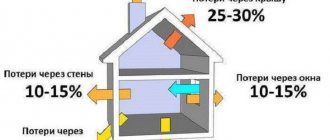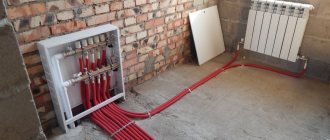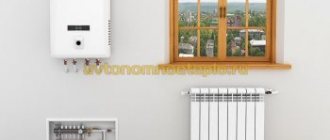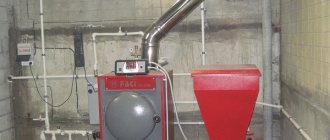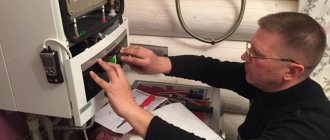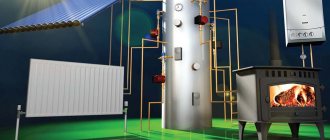In country houses, issues related to heating are not always easy to solve, since centralized city communications are out of reach and it is impossible to connect to them.
To effectively consume heat and increase the level of comfort when installing heating, you can install a heated floor system. Such artificial heating will allow for a more rational distribution and regulation of heat flows in the house. Gas boilers can heat water heated floors in a matter of minutes.
Connection
If the choice fell on heating using underfloor heating, then you will have to make the correct connection to the radiators.
A significant investment will be required, which will be aimed at piping the solid fuel boiler. In this case, you simply cannot do without a buffer capacity. The main reason is that it is quite difficult to heat a water floor to the required temperature using firewood, because we are talking about maintaining the temperature inside the system. Such a system requires timely heat release, otherwise the existing water jacket may overheat and even boil. It is very problematic to heat the coolant to 40°C using solid fuel, since its operating temperature is about 55°C. If the temperature drops, this will lead to the formation of condensation, which will eventually create holes in the metal walls. Even if you use a cast iron boiler, this will not help to avoid possible corrosion. In the presence of condensation, a characteristic deposit begins to form, which does not allow the fuel to burn efficiently. To maintain the efficiency of the entire system, it is necessary to install a heat accumulator.
Collector diagram
The cabinet must be located in a room whose space provides free access for supply and return pipes. The side outlets of the manifold are connected to the ends of these elements to supply and receive heating fluid. Before performing the last step, it would be useful to install protective shut-off valves and temperature regulators in the system.
To simplify this entire procedure, many manufacturers began to produce ready-made valves that include not only the elements described above, but also shut-off valves for all outlets of underfloor heating pipes and radiators, which provide for disconnecting some circuits of the system when the main part of it remains turned on.
Valves, pipe ends and the manifold are connected using compression adapters - fittings that have completely different inlet and outlet sizes depending on consumer preferences. Often, the outlet pipes of a heated floor are connected to the collector using connectors that include a support sleeve, a ring with a clamp and a brass nut. The simplest connection consists of simple clamps with locking valves. The supply and return pipes are connected to the manifold, and it, in turn, is attached to the floor coolant outlets.
The named scheme is the simplest and will not be able to fully ensure proper control over the entire heating system, since it completely depends on the type of boiler (the only thing is that the shut-off valve can be closed a little to slightly reduce the supply of heating mass).
Types of boilers
All boilers are divided into two types:
- Double-circuit products.
- Single circuit products.
Double-circuit devices are capable of performing several tasks: water heating and heating. The water is heated due to the fact that such a boiler is equipped with a storage boiler. And some models, instead of a boiler, are equipped with a supply heat exchanger, which also provides water heating.
Single-circuit devices. In a heating system, such boilers only heat the coolant, that is, they can only be used to heat the house. But in order for them to provide water heating, then you need to additionally purchase: boilers, mixing units and many other devices. Only in this case will it be possible to connect a warm floor.
Based on the type of installation, boilers are divided into two categories:
- Suspended-type equipment, the power of which reaches up to thirty-five kilowatts.
- Floor-standing boilers have a power of up to one hundred and twenty kilowatts.
Among these two types, suspended models are the most popular because they require significantly less cost and are easy to install. Wall-mounted boilers are equipped with a circulation pump and other devices that are necessary for a boiler room. In order to put such equipment into operation, all that needs to be done is to attach pipes through which hot water will flow and connect the heating pipeline. Models that are equipped with a storage boiler are ready-made small boiler rooms from which water for the batteries will be heated.
If you are interested in which boiler is better to choose and how to connect a heated floor, you first need to find out what types of such equipment exist. To install a warm water floor system in your house, which will be heated by a boiler, you can consider the following types of automatic heating devices:
Electric water heating equipment.
- Single-circuit gas boiler.
- Double-circuit gas equipment.
To heat a water floor, you can choose any of these types, but there is an important condition here - the operation of such equipment must be automated. Most often, electric or gas 2-circuit equipment is chosen
However, if we take into account that the price of energy resources is constantly increasing, then installing a gas boiler is much more profitable from an economic point of view. However, in order to make a water heated floor connected to such equipment, you need to provide a separate room in advance, and also equip a good ventilation system.
In addition, a collector can be installed in a separate boiler room. A gas 2-circuit unit will be able to warm up the air well, plus it will provide the house with hot water. However, its installation for a warm water floor must be carried out in compliance with a number of important rules. Such work should be carried out by gas service workers, but independent installation of gas equipment will be considered illegitimate and will not meet accepted standards.
Installing an electric boiler, unlike a gas one, is not particularly difficult and can be done independently. Such heating equipment is environmentally friendly, which cannot be said about other types of boilers; moreover, the connection diagram for a heated floor to such a boiler does not require special knowledge. However, this unit has one big disadvantage - the high price of electricity, which is constantly growing. Electric heating devices can be installed both in private houses and in city apartments.
The diesel unit for the “warm floor” system is most suitable for installation in cottages. Installing such equipment is not very difficult; their installation scheme is quite simple. Diesel models are easy to use, however, in order to maintain their smooth functioning, they need to be constantly monitored.
Solid fuel heating units are also suitable for country houses. For their work, coal briquettes are used. As for the power of solid fuel boilers, it, like the efficiency (efficiency factor), is very high. In houses with heating radiators, a solid fuel unit is considered the best option.
It doesn’t matter which of these boilers you choose, before purchasing it you need to calculate its power, you also need to correctly find the place where the heated floor will be connected, and purchase additional devices, such as a storage boiler, etc.
Features of heating with liquefied gas
The owner of a liquefied gas heating system is forced to monitor whether the fuel in the container connected to the boiler is running out. Some may consider this feature an inconvenience, but such a heating system can be autonomous and not depend on problems with the central gas supply. You just need to regularly replace gas cylinders or immediately pump a sufficient amount of gas into the underground storage.
Use of gas cylinders in heating
For ease of use, gas cylinders are combined into a single battery.
The option of heating a house with liquefied gas in 50-liter cylinders is ideally suited for country houses and small cottages. To avoid having to disconnect an empty cylinder every two days and connect a full one in its place, you can combine several cylinders into a battery at once. For this purpose, GOK fittings are used. If a homeowner installs liquefied gas heating with his own hands, he has the right to install a battery of no more than 3 cylinders without a project. A larger number of them will require a project.
Gas cylinders are installed not indoors, but in a metal cabinet on the outside of the house. In winter, there are often cases of reduced gas supply through the reducer due to the fact that the condensate contained in the cylinders partially freezes.
To prevent freezing of gearboxes at low temperatures, you can install a small electric heater in the cabinet with cylinders.
Gas holder for home heating
It is better to refill the gas tank in advance, when weather conditions allow the car to drive up to the house.
It is convenient to use cylinders when gas consumption is not too high, and their delivery service operates uninterruptedly. In other cases, it will be more rational to purchase and install a gas tank - a large underground tank for storing LPG, which will have to be filled with gas only 2-3 times a year. The volume of the gas holder can be from 3 to 10 cubic meters; it is selected in accordance with the power of the heating system.
An underground gas tank is allowed to be located no closer than 10 m from a residential building, and from the road side it must be accessible for a refueling vehicle.
How to choose a solid fuel boiler for heated floors
When heading to the store to buy a solid fuel boiler, most people have no idea what exactly to look for. They rely on salespeople who often act in their own interests
Let's consider the issue of choice more carefully. The main criteria for a solid fuel boiler are the following parameters:
- Power.
- Power regulator.
- Energy dependence.
- Method of heating water.
Let's look at each of them in more detail.
When calculating the power, they take into account how well the room is insulated, as well as its area. On each boiler, the manufacturer indicates the volume that can be heated by the boiler in the absence of heat loss
Otherwise, buy a solid fuel boiler with a power 24% more than needed.
Manufacturers produce boilers with and without power regulator. It can operate automatically or manually. The first option is more economical.
The use of energy dependence in the design of a solid fuel boiler increases its performance, but makes the boiler dependent on the electrical supply and reduces the level of autonomy.
The method of heating the water plays an important role..
When a device is required not only for heating the house, but also for supplying hot water, then a double-circuit boiler is chosen, since it heats the water in flow mode. If a storage device is needed, a buffer capacity is installed.
Collector distribution unit
The collector unit allows you to control the temperature.
Installing the collector unit resolves the issue of how to connect a water heated floor. The collector unit is a wiring that makes it possible to control the temperature in circuits located in adjacent rooms.
The collector unit is a complex technical device. Different components of the unit depend on the number of circuits. The collector system is equipped with thermostats. The devices regulate the heating of coolants in each circuit separately:
| № | Location of underfloor heating circuits | Average temperature °C |
| 1 | Living spaces | 26 |
| 2 | Kitchen, bathroom | 31 |
| 3 | Non-residential premises | 25 |
| 4 | Children's room | 27 |
You can assemble a warm floor with your own hands, but the installation and adjustment of the collector unit should only be performed by a qualified plumber.
Safety requirements
Safety requirements for operating gas equipment are almost the same for all types of boilers.
Basic provisions
:
- a separate room is required to accommodate the gas boiler;
- The boiler room must be equipped with a gas analyzer so that in case of gas accumulation (for example, spontaneous extinguishing of the burner) it can be notified in time;
- there should be no foreign objects in the boiler room, especially flammable ones - paint, solvent, chemicals, etc.;
- the boiler must be free for air flow, it is prohibited to lean or lean anything against it;
- If you detect a smell of gas, immediately turn off the supply, notify the gas service and ventilate the room. When using propane-butane, ventilation may be useless, since it is heavier than air and accumulates at the bottom;
- Do-it-yourself repair of boiler safety sensors is prohibited.
The requirements are simple, but they must be strictly observed to avoid dangerous consequences.
DIY installation and connection of the boiler
A long-burning solid fuel boiler is sometimes installed with your own hands; for this you should follow a certain procedure:
- Perform preparations. Drawings and diagrams are checked. They choose the future premises, pour a concrete platform on which the equipment is mounted.
- Establish communications.
- Perform tying. The most labor-intensive stage of work. All communications are being connected. If the model is double-circuit, the return flow for water heating is connected. Next, a connection is made for additional equipment, for example, a buffer tank. If necessary, a draft regulator is installed.
- Install a brick chimney or other combustion exhaust element.
- Check the smoke exhauster and chimney.
- Perform final preparatory work.
- The system is started.
That’s all, the long-burning solid fuel boiler “Palych” (or any other) has been installed with your own hands and is ready for use. The first launch is performed outdoors. Pressure tests are also carried out before it. Turn on the water supply, having previously opened all plugs and valves, raise the system pressure to 1.3 Atm. Check the boiler for leaks
Particular attention is paid to joints and welding connections
Choice
First of all, you should choose a water heater for underfloor heating of suitable power.
Calculating the power of a boiler is a difficult task; the easiest way is to proceed from the average value - 1 kW of power per 10 sq. m. area. It is necessary to pay attention to the possibility of adjusting the boiler operating mode. It is best if there is the possibility of smooth adjustment. It is also necessary to decide on the required number of circuits, type of installation and other characteristics of the boiler that will best meet the requirements of the existing room
It is also necessary to decide on the required number of circuits, type of installation and other characteristics of the boiler, which will best meet the requirements of the existing premises.
How to make a heat accumulator with your own hands
A do-it-yourself heat accumulator for a solid fuel boiler is an energy-efficient and simple design, representing a container in the middle of which there is a coolant that receives and stores energy. After the boiler has completed its operating cycle, the room is heated by absorbing the previously collected energy. Thanks to this, the heat accumulator significantly increases its efficiency and significantly saves resources.
Heating from a solid fuel boiler (installed by yourself) with a heat accumulator consists of many spiral tubes that are located around the entire perimeter of the container. This arrangement is explained by the fastest possible use of heat. Each of the spiral circuits located in the container is responsible for one action. For example, the first receives the generated thermal energy, the second heats the area of the room (building), the third heats water for domestic purposes.
Advantages of using a heat accumulator:
- Accumulation and concentration of thermal energy.
- Possibility of combining two or more heat sources.
- Increase in productivity.
- Availability of water heating.
- Temperature adjustment.
A solid fuel boiler with a water circuit, installed by yourself, allows you to save money when it is equipped with a heat accumulator.
To make your own heat accumulator for a boiler, you will need a large capacity. It is almost impossible to make it yourself. The ideal option is a stainless steel tank or any container with a lid. The thickness of the steel used is 4-9 mm. The preferred shape is a cylinder or sphere, in extreme cases a cube.
A suitable option is a barrel. For a cottage or country villa, the minimum barrel volume for a solid fuel boiler starts from 1 ton. On large containers, before using them, stiffening ribs are welded on, which will significantly strengthen them.
Having received the necessary container, think about its location, since in the future it will be much heavier. Next, diagrams and drawings will be needed.
Let's look at the step-by-step production of a heat accumulator for a solid fuel boiler. The procedure for its manufacture:
- A flange is welded to the size of the cover. In the future it will be used for bolted connections. To seal the lid, stiffeners are installed.
- The surface inside is treated with orthophosphoric acid (solution), primed 4 to 6 times and covered with two to three layers of high-temperature paint.
- Welding work is being carried out. Coils are welded inside the barrel.
- If possible, powder coating is done along with the coil. It allows you to obtain a high-quality coating, which increases anti-corrosion properties.
- The main tank and coil are checked for leaks.
- The outside of the barrel is being sanded and painted. The preferred paint is silver.
- Insulated with a layer of aluminum foil and a thick ball of min. cotton wool.
Safety requirements:
Considering that the heat accumulator for a solid fuel boiler is constantly heating up, fire safety rules must be observed
Anything that catches fire quickly and easily is moved to a safe distance. A closed type system will have a fairly high coolant pressure; accordingly, special attention should be paid to welds, joints, and connections. It is also necessary to install heat-resistant rubber gaskets on the lid that can withstand the operating temperature of the coolant. In the case of using heating elements for additional heating, it is necessary to comply with electrical safety rules: the tank must have an “earth”, that is, grounding, and the contacts must be insulated.
Their use is beneficial when:
- Needs for supplying hot water to large facilities (public baths, hospitals, kindergartens, schools).
- Use of fuel materials.
- The use of thermal compressors (makes their work more balanced).
As you can see, installing a solid fuel boiler with your own hands is a rather simple and primitive thing, but at the same time it has a number of features. The element is installed both in an apartment and in a private house. Installation costs are minimal, savings are maximum. The assortment is varied, everyone will find something that suits them. Also, it should be noted that you can make a solid fuel boiler with your own hands for the garage. If you are not confident in your own abilities, call a specialist, he will do all the necessary work efficiently and on time.
Screed
IMPORTANT: the top layer of screed is poured only when the contour is filled. But before that, the metal pipes are grounded and covered with thick plastic film
This is an important condition to prevent corrosion due to electrochemical interactions of materials.
The issue of reinforcement can be solved in two ways. The first is to place a masonry mesh on top of the pipe. But with this option, cracks may appear due to shrinkage.
Another method is dispersed fiber reinforcement. When pouring water-heated floors, steel fiber is best suited. Added in an amount of 1 kg/m3 of solution, it will be evenly distributed throughout the entire volume and will qualitatively increase the strength of hardened concrete. Polypropylene fiber is much less suitable for the top layer of screed, because the strength characteristics of steel and polypropylene do not even compete with each other.
Install the beacons and mix the solution according to the above recipe. The thickness of the screed must be at least 4 cm above the surface of the pipe. Considering that the pipe ø is 16 mm, the total thickness will reach 6 cm. The maturation time of such a layer of cement screed is 1.5 months
IMPORTANT: It is unacceptable to speed up the process including floor heating! This is a complex chemical reaction of the formation of “cement stone”, which occurs in the presence of water. And heating will cause it to evaporate
You can speed up the maturation of the screed by including special additives in the recipe. Some of them cause complete hydration of cement within 7 days. And besides this, they significantly reduce shrinkage.
You can determine the readiness of the screed by placing a roll of toilet paper on the surface and covering it with a pan. If the ripening process is over, then in the morning the paper will be dry.
Adaptability to working with heated floors
Most boilers are designed for traditional heating systems, that is, they produce a coolant with a temperature of 60-95 o C. The peculiarity of water floor heating is that much lower temperatures are required: about 35-50 o C. Only under such conditions the floor should not be burned it will be, but it will be pleasantly warm.
There are two solutions: find an installation that can dispense warm rather than hot water, or mix cold water with the hot water, and only then dispense it into the pipes. The second solution requires additional equipment - a collector unit, in which mixing occurs. This is not the cheapest technology, as it requires measuring the temperature of the hot water and return water, mixing them until the temperature drops to the desired level. Of course, collector units are different, more or less expensive, but they still need to be purchased and installed.
Let's start with boilers for water floors, which can themselves produce coolant at the required temperature. Here in the first place are electric thermal units. You can set the temperature yourself from 25 o C and above. That is, no additional costs and comfortable work with heated floors. In addition, induction and electrode (ion) boilers have very small dimensions, which makes them easier to install. If you have only one circuit, you can connect it directly to the output. If there are several circuits, a heated floor comb will be needed, but the simplest one, without mixing and temperature controllers. In principle, you can make it yourself from pipes and fittings. Other equipment may require (or not, depending on the configuration) an expansion tank, a drain valve and a circulation pump.
There is another option that simply shows excellent efficiency when working with low-temperature networks - this is. They are most effective when the coolant temperature in the return pipeline is not higher than 35 o C. That is, this is an excellent option for a water floor.
The best choice is a condensing gas boiler for heated floors
Gas boilers using traditional heat extraction technology require the installation of a mixing unit with control elements. If you decide to use such equipment, try to choose a model that can work with two or more circuits simultaneously. Usually one of them is high-temperature for radiators, and the rest are for low-temperature systems such as underfloor heating. In this case, monitoring the temperature and mixing the coolant is done automatically and everything happens inside the installation. So if your water heated floor works simultaneously with radiator heating, such equipment is an excellent solution.
The situation is more complicated with boilers using pellets and liquid fuel: for them, a collector (mixing) unit is required. And with all the stuffing: thermometers, controllers and thermal heads.
Wiring high-temperature boilers for heated floors is not the easiest task
What lies behind the technology
Such efficiency was achieved by providing the system with convection. The lower the installation level, the more evenly the surface of the floor covering will warm up. When connecting warm gas floors to the boiler, it is necessary to install an entire system of pipes under the floor. Additionally, a distribution manifold and circulation pump are installed. The collector is used when installing a heated water floor. Hot water enters the manifold from the boiler, after which it evenly fills all existing circuits. Passing through them, it heats the floor surface, and after cooling it returns back to the boiler.
General scheme
The system also needs to be equipped with additional control devices, such as:
- the thermostat is installed in any case, including under a heating boiler;
- a pressure gauge helps monitor the level of water in the system;
- check valves (their number depends on the level of complexity of the system and its size).
Connection diagram
Different contours will be needed for rooms of different sizes. The maximum system capacity and pipe length will have a number of design limitations. Compliance with the basic parameters when installing a water floor is more important than when installing an electric one. The cable will heat up evenly along its entire length, but over time the water passing along the circuit will cool down. One circuit is designed to heat a room whose area does not exceed 35 square meters.
The laying scheme depends directly on the size of the room. For large rooms it is better to use a spiral, while for small rooms it is recommended to use a snake. In rare cases, it is necessary to resort to a combination of schemes, but this issue should be dealt with by a professional. The pitch between turns can be from 15 to 25 cm. To complete the contour, you need to use only one pipe. It is recommended to use pipes made of metal-plastic. Such designs will bend well, be inexpensive and sold in bottles. If it is necessary to connect several individual elements within a circuit, then welding should be used. Couplings are suitable for mechanical connections, but they can only be used in open areas.
Laying scheme
Degree of autonomy
Requirements for the comfort of heating equipment are not the whims of spoiled consumers: not everyone has the opportunity to constantly monitor the operation of the heating system and add fuel. That’s why we consider this parameter first.
The highest degree of autonomy in . There is electricity - they work without human intervention. Moreover, after a power failure, they start working independently; many of them have “memory” and save settings. But there are three types of electric colas:
- on heating elements;
- electrode;
- induction
An electric boiler for underfloor heating with heating elements is a traditional solution. They just have one “disease” - heaters burn, and quite often. But their cost is average, and the technologies have been tested and proven; even a person who is not very good at communicating with technology can replace a burnt-out heating element. In general, a good (but not the best) option.
The most “independent” are solid fuel installations. You need to add fuel to them often, regularly remove ash and slag, and regulate the intensity of combustion. Of course I have, . The best models can work on one bed of coal for several days (up to 7 days for some models from the company). But there are also difficulties here: they are demanding on fuel (you need dry firewood or coal of a certain standard), and the price can also be a deterrent.
A solid fuel boiler for water heated floors requires constant human presence. Pyrolysis units and long-term combustion units require “refueling” two to three times less often
You can use a regular solid fuel boiler for a water heated floor, but you will have to spend a lot of time near the stove. Although there are already solid fuel units with automated supply. They are equipped with pellet-type bunkers and a screw feed. Only the requirements for the size and quality of fuel in them are no less stringent than those that run on pellets. But you can leave your home for a few days and not be afraid that the system will expand.
Fifth place for liquid fuel - it's not cheap. Operating costs also include the need to heat the fuel tank, or install the tank in a heated room. In addition, installations using diesel fuel require a boiler room. Moreover, it is better to build a boiler room at a decent distance from the house: the noise during operation of the burner is decent, and the smell is strong, and it penetrates everywhere.
It is generally accepted that the most expensive heating is electricity. But when using automated modern devices you have to pay only a little more than when using coal or firewood. So don’t discount electric boilers for heated floors. It’s just that for more economical heating, it is advisable for you to take a heating unit with the ability to adjust the power. In some traditional electric boilers, heating elements are assembled in groups, and automation, turning the groups on/off, regulates the operating power and saves energy. For heated floors, it is advisable to take a three-stage, or, in extreme cases, a two-stage unit. Induction and electrode boilers themselves are economical (if controlled electronically) and have low inertia, that is, they do not waste energy.
Advantages of heated floors
Warm floors, compared to other methods of heating a house, provide the most uniform distribution of heat generated over the area of the room they heat. Flows of warm air from the floor rise vertically, displacing cooler air from the ceiling. As a result, constant natural convection currents are formed in the room. Convection provides effective heating of the entire room - at a minimum temperature of the coolant, the room receives maximum heat.
The temperature of the coolant in water heated floors must be maintained at 35-40 0 C. For radiator heating, the system must have a coolant supply at a temperature of 55-65 degrees. Thus, heating the underfloor heating system requires less thermal energy, and, therefore, the cost of heat production is lower. It is by reducing the cost of heat production that savings are achieved without loss of heating quality. In addition, the entire heated floor cake accumulates the released heat and, when circulation stops, will release thermal energy into the room for some time.
Pipe laying
Selecting the correct pitch between turns of pipes and calculating the length of the pipes will allow you to correctly calculate the amount of heat distributed throughout the room. If you successfully calculate these parameters, then cost savings are guaranteed.
Requirements for rational use of the structure:
- The length of the liquid circuit is around 70 meters, preferably no more.
- Alternating cold and hot water flows leads to economical use of water.
- Determining the location of furniture where the floor does not need heating. Calculation of the pitch between turns of pipes and maintaining the distance when installing the system.
- After heating the pipes to the maximum level, the temperature is reduced by 20 degrees. This move allows you to save more while maintaining the desired room temperature.
- Elimination of improvisation and strict adherence to instructions.
Types by fuel type
Heating boilers are a fairly large group of devices that have different principles of operation. According to the type of fuel (energy source), boilers are
:
- Gas
. The most efficient and economical boilers. The cost of 1 kW of energy is the lowest, and the efficiency is the highest. - . Water is heated using heating elements, electrodes or induction. The easiest to maintain and most expensive source of heating fluid.
- Solid fuel
. Boilers that use almost everything that burns as fuel - wood, coal, briquettes, pallets, etc. The availability of fuel makes such a boiler most suitable for autonomous heating of a house, but the combustion chamber has to be constantly filled. Modern models, however, are capable of long-term combustion without human intervention. - Diesel
. The source of thermal energy is burning diesel fuel. A diesel fuel boiler can operate independently for a long time - up to several months. This type of boiler may turn out to be more profitable than even a gas one, if it is not connected to the mains, but uses imported gas. - Combined
. Boilers that have the ability to switch to another type of fuel if necessary. The design of such a boiler can have two fireboxes, or one universal for different types of fuel; you just need to replace the burner. At the same time, there are universal boilers with the option of converting wood to electricity when a second firebox is not needed. The ability to have an alternative heating option is a valuable quality for a country house when fuel shortages are possible.
Results
So, what should you choose? The best option is a gas boiler for heated floors with condensing heat extraction technology. In all three respects, it occupies good positions. The situation is a little worse if you install a gas installation with a “warm floor” function. But, unfortunately, not everyone has the opportunity to connect to main gas. And then the easiest way to implement a water heated floor with an electric boiler. A small electric boiler can be installed to heat heated floors in utility rooms, for example, in a garage or in a country house: it is very easy to install. The next “quality” unit is a pellet unit, followed by liquid fuel. The most difficult task and high costs await when using solid fuel boilers for water floor heating.
